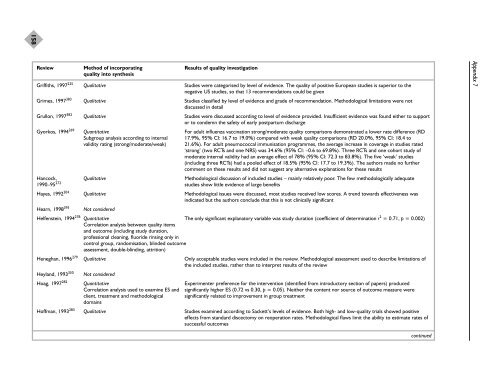Evaluating non-randomised intervention studies - NIHR Health ...
Evaluating non-randomised intervention studies - NIHR Health ...
Evaluating non-randomised intervention studies - NIHR Health ...
Create successful ePaper yourself
Turn your PDF publications into a flip-book with our unique Google optimized e-Paper software.
158Review Method of incorporating Results of quality investigationquality into synthesisGriffiths, 1997 225 Qualitative Studies were categorised by level of evidence. The quality of positive European <strong>studies</strong> is superior to thenegative US <strong>studies</strong>, so that 13 recommendations could be givenGrimes, 1997 383 Qualitative Studies classified by level of evidence and grade of recommendation. Methodological limitations were notdiscussed in detailGrullon, 1997 382 Qualitative Studies were discussed according to level of evidence provided. Insufficient evidence was found either to supportor to condemn the safety of early postpartum dischargeGyorkos, 1994 269 Quantitative For adult influenza vaccination strong/moderate quality comparisons demonstrated a lower rate difference (RDSubgroup analysis according to internal 17.9%, 95% CI: 16.7 to 19.0%) compared with weak quality comparisons (RD 20.0%, 95% CI: 18.4 tovalidity rating (strong/moderate/weak) 21.6%). For adult pneumococcal immunisation programmes, the average increase in coverage in <strong>studies</strong> rated‘strong’ (two RCTs and one NRS) was 34.6% (95% CI: –0.6 to 69.8%). Three RCTs and one cohort study ofmoderate internal validity had an average effect of 78% (95% CI: 72.3 to 83.8%). The five ‘weak’ <strong>studies</strong>(including three RCTs) had a pooled effect of 18.5% (95% CI: 17.7 to 19.3%). The authors made no furthercomment on these results and did not suggest any alternative explanations for these resultsHancock, Qualitative Methodological discussion of included <strong>studies</strong> – mainly relatively poor. The few methodologically adequate1990–95 272 <strong>studies</strong> show little evidence of large benefitsHayes, 1992 204 Qualitative Methodological issues were discussed, most <strong>studies</strong> received low scores. A trend towards effectiveness wasindicated but the authors conclude that this is not clinically significantHearn, 1998 395 Not consideredHelfenstein, 1994 278 Quantitative The only significant explanatory variable was study duration (coefficient of determination r 2 = 0.71, p = 0.002)Correlation analysis between quality itemsand outcome (including study duration,professional cleaning, fluoride rinsing only incontrol group, randomisation, blinded outcomeassessment, double-blinding, attrition)Heneghan, 1996 279 Qualitative Only acceptable <strong>studies</strong> were included in the review. Methodological assessment used to describe limitations ofthe included <strong>studies</strong>, rather than to interpret results of the reviewHeyland, 1993 350 Not consideredHoag, 1997 282 Quantitative Experimenter preference for the <strong>intervention</strong> (identified from introductory section of papers) producedCorrelation analysis used to examine ES and significantly higher ES (0.72 vs 0.30, p = 0.05). Neither the content nor source of outcome measure wereclient, treatment and methodological significantly related to improvement in group treatmentdomainsHoffman, 1993 283 Qualitative Studies examined according to Sackett’s levels of evidence. Both high- and low-quality trials showed positiveeffects from standard discectomy on reoperation rates. Methodological flaws limit the ability to estimate rates ofsuccessful outcomesAppendix 7continued
















